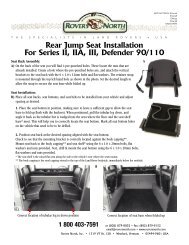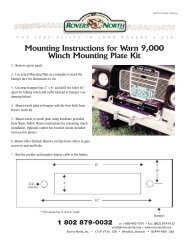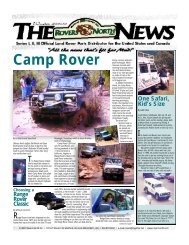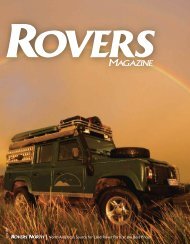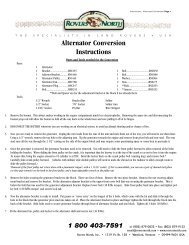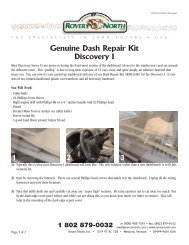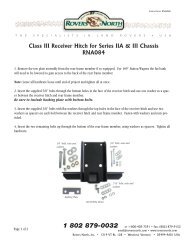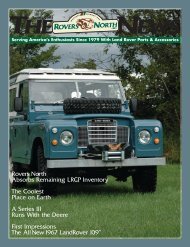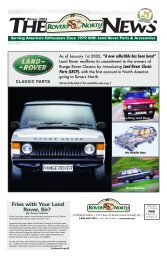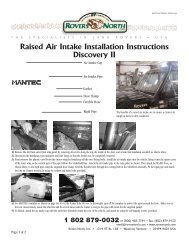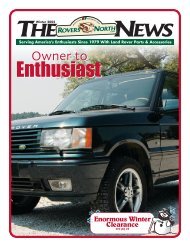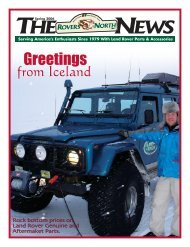Create successful ePaper yourself
Turn your PDF publications into a flip-book with our unique Google optimized e-Paper software.
soil – frozen vs. wet vs. dry, type of soil – clay, grass, sand,<br />
rock, etc. - gradient of slope, adhesion factors (suction), and<br />
weather conditions. Basically it relates to when we look under<br />
the truck in the mud bog and state: “Shucky down Bubba,<br />
we’re mired down good this time! Go get the tractor, JD.”<br />
Now, back to Arizona, where getting that propane truck<br />
unstuck from the soft, dry sand took some serious planning.<br />
We had two vehicles with Superwinch 16.5K winches on them<br />
that we positioned slightly apart, rigged up the ropes and set<br />
some sand ladders (I use MAXTRAX) under the propane<br />
truck’s rear tires to help raise the frame up off the sand as it<br />
moved back. We also had to set a Pull-Pal to anchor one of the<br />
winch rigs since it wanted to move toward the propane truck.<br />
As we winched the propane truck back to terra firma we kept<br />
alternating the MAXTRAX (we had 4) under the rear tires<br />
which kept the heavy vehicle from sinking again. This effort<br />
helped reduce the Mire Factor once the propane truck started<br />
moving.<br />
<strong>The</strong> winching effort was pretty sizeable at first since there<br />
was a lot of dead weight to move. <strong>The</strong> Mire Factor involved the<br />
very heavy vehicle, soft dry sand, all tires half way down on a<br />
level surface. And let’s not forget about that darn propane tank<br />
being full! It was a typical sunny day in the Sonoran Desert.<br />
Once the initial pull got the vehicle rolling the winch trucks<br />
had an easier time of it. I had the driver of the propane truck<br />
slightly load the torque converter while in reverse gear. This<br />
kept the drive train slightly moving but not spinning. It helped<br />
with the lessening of the resistance.<br />
Sometimes the initial effort to move stuck vehicles can<br />
overpower recovery equipment if that equipment is not<br />
specced correctly. A standard SUV that has a curb weight of<br />
4200 pounds might require an initial effort of 8400 pounds to<br />
get the vehicle moving. Once that vehicle starts moving it<br />
becomes “rolling resistance” and can be as low as 1000<br />
pounds of drag.<br />
Factors vary on all recovery scenarios, of course. That is<br />
why I usually recommend most winches be purchased based<br />
on 1.5 times the gross vehicle weight as a starting point. Work<br />
effort can be lessened by using a pulley block in the rigging.<br />
Understanding the rating capacities of the equipment<br />
being utilized for the rigging during any extraction operation is<br />
ultimately important. Make sure the winch, jacks, attachment<br />
devices and attachment points are all rated with the proper<br />
WLL [working load limit] and have met industry standards<br />
for Proof Testing and Design Factor conditions.<br />
See you on the trail, ‘cause you won’t be stuck that long, right?<br />
P<br />
Vocabulary:<br />
Design Factor: An industry term denoting a product’s theoretical reserve<br />
capability usually computed by dividing the catalog ultimate load by the<br />
WLL. Generally expressed as a ratio, e.g. 5 to 1 or 5:1; also denoted as a<br />
Design Safety Factor.<br />
Tackle Block: (or Block) An assembly consisting of a sheave, side plates,<br />
and generally an end fitting. An end fitting can consist of a hook, shackle<br />
or eye. Also known as “tackle block and sheave” assembly (herein<br />
referred to as TB&S). Side plates may also be referred to as the “cheeks”<br />
of the block.<br />
Sheave or Sheave and Bearing Assembly: A wheel with a grooved<br />
rim for wire or rope to run on while transmitting force during lifting or<br />
hauling. Usually used to guide or change the direction of the rope or wire.<br />
Sheaves are configured with a central hub that supports different type uses<br />
and will be machined with a plain bore or with a bearing surface.<br />
Plain Bore: very slow line speed, very infrequent use, low load, merely a<br />
hole bored in the center of the sheave.<br />
Bronze Bushing: slow line speed, moderate load, moderate use.<br />
Roller Bearing: faster line speed, more frequent use, greater load. Comes<br />
in tapered rollers or straight rollers machined to facilitate the shaft applicable<br />
to the block use.<br />
Snatch Block: A type of TB&S that allows the user to open the block to<br />
thread the line without removing attachments on the line end. Snatch<br />
blocks are intended for infrequent and intermittent use with slow line<br />
speeds. Most commonly used TB&S in 4x4 vehicle recovery.<br />
Pulley: <strong>The</strong> common or “laypersons” term for a grooved wheel. See<br />
Sheave.<br />
Reeving: A term used to describe the path of the rope through a system<br />
of blocks (or one block). A reeving diagram is a pictorial rendering of the<br />
desired path for the rope. (part of the 3 p’s)<br />
Shackle: Industry standards dictate the use of Screw Pin Shackles which<br />
can be used for “in-line” pulling as well as loads where “side-loading” may<br />
occur. Side-loads will decrease the rated capacity. Never let the screw pin<br />
rotate under “live line” while in application. <strong>The</strong>re are shackles applicable<br />
to chain, sling and general usage. Use only shackles with markings forged<br />
into the product. Look for markings like WLL or SWL with a tonnage designation<br />
such as: 4.75T or 6.5T. Style names like Bow or “D” are common<br />
terms. “D” type looks like a d when held sideways. Bow types are more<br />
rounded and more common to 4-wheelers. <strong>The</strong>re are “pin” type shackles<br />
that utilize “cir-clip” type closures. Only use Screw Pin type shackles. Size<br />
and rating designations appropriate for the vehicle at minimal 1.5 times<br />
the GVW.<br />
Gross Vehicle Weight: GVW, GVWR(rating), GA(xle)WR,<br />
C(ombined)AWR – are all applicable to helping decide how much the vehicle<br />
might weigh when loaded. <strong>The</strong> best way is to get to a truck scale – try<br />
a movers’ warehouse, truck stop scale, salvage yard, land fill – they will<br />
weigh your vehicle for a few dollars. Load it up for the three day trip, kids<br />
and dogs, cooler and gear. <strong>The</strong>n write this number with a sharpie on the<br />
drivers door jam for future reference.<br />
35



